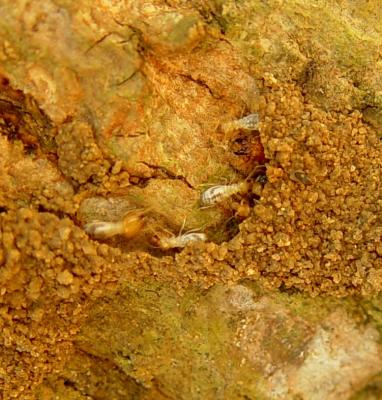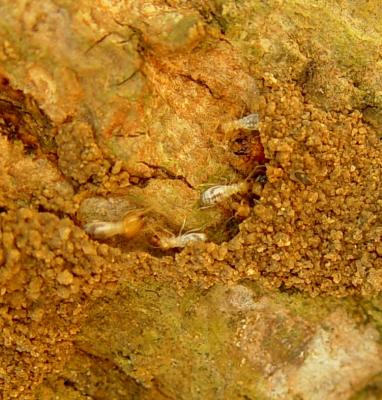

Termites
Termites are serious groundnut pests throughout the southern African region and West Africa. Species of Microtermes and Odontotermes are the most damaging, while Macrotermes cause occasional damage. The small-sized Microtermes spp., in particular, attack and invade growing groundnut plants through the roots and stem near ground level, hollowing them out and causing the plants to wilt and die with a consequent reduction in crop stand.
Roots damaged by other soil pests, such as white grubs, are also prone to attack by termites. Some termite species (Macrotermes spp., Hodotermes mossambicus) cut off stem bases, and may cause 25-100% of plant losses. As the crop ripens the outer layers of the pods are scarified (removal of soft corky tissue between the veins of the pod) by termites allowing contamination of the seed with soil fungi, such as Aspergillus flavus, which produce lethal "aflatoxins".
Scarification of pods is by far the most common type of termite damage at plant maturity, a factor often aggravated by late harvest. Scarification as high as 30% has been reported. Infested plants are not obviously diseased and are frequently harvested and contaminate the rest of the crop. Species such as Microtermes spp. also penetrate the pod to feed off the soft inner lining, filling the pod with soil. This form of attack leads to additional loss through premature germination of kernels. Stacks of plants left drying in the fields are also frequently attacked by species such as Odontotermes spp. with farmers losing between 30-40% of their crop at this stage.
Termite damage is generally most serious towards the end of the growing season just prior to harvesting, and it is particularly serious during periods of drought (ARC/LRN. 2007).
- Remove residues of previous cereal crops (sorghum, millet and maize). Plant residues left in the field serve as food for termites, which may infest the new crop. Termite infestation of 100% has been observed in groundnut crops with high plant residues.
- Planting should be carried out early enough to avoid drought periods. Moisture deficiency may stress a crop and lead to attack by termites due to low vigour.
- Harvest promptly. Research has shown that termite damage increases with delay in harvest. Furthermore, most groundnut-producing areas in sub-Saharan Africa experience drought and high temperatures during the later part of the growing season, conditions that favour termite infestation as well as fungus (A. flavus) infection of pods leading to aflatoxin formation in seeds.
- The complete destruction of mounds and removal of queen termites are effective control measures against mound-building species (Macrotermes spp.). Partial destruction of mounds is unlikely to solve the problem, since replacement reproduction may develop from the remaining termites.
- It has been reported that close spacing in groundnut helps to deter termite infestation, although the reason for this was not given. However, high density sowing, followed by thinning of surviving plants where necessary to reduce competition, offsets anticipated losses due to termites.
